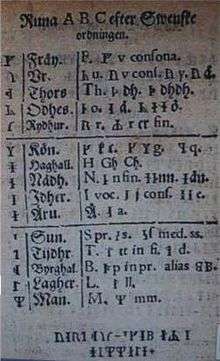Modern runic writing
Runic alphabets have seen numerous uses since the 18th-century Viking revival, in Scandinavian Romantic nationalism (Gothicismus) and Germanic occultism in the 19th century, and in the context of the Fantasy genre and of Germanic Neopaganism in the 20th century.
Early modern period and Viking Revival


The use of medieval runes mostly disappears in the course of the 14th century. An exception are the Dalecarlian runes, which survived, heavily influenced by the Latin alphabet, into the 19th century. Occasional use of runes also seems to have persisted elsewhere, as evidenced by the 16th-century Faroer Fámjin stone.
Antiquarian interest in runes first arises in the 16th century, with the 1555 Historia de gentibus septentrionalibus by Olaus Magnus, and picks up in the 17th century, notably with Peder Resen's Edda Islandorum of 1665. In the 17th century, runology pioneer Johannes Bureus published his Runa ABC, the first Swedish alphabet book.
Runic calendars are perpetual calendar based on the 19-year-long Metonic cycle of the Moon. They may originate as early as in the 13th century, but most surviving examples date to the early modern period. Most of the several thousand which survive are wooden calendars date from the 16th century onward. Around 1800, such calendars were made in the form of tobacco boxes in brass.
Esotericism
Germanic mysticism and völkisch symbolism
The pioneer of the Armanist branch of Ariosophy and one of the more important figures in esotericism in Germany and Austria in the late 19th and early 20th century was the Austrian occultist, mysticist, and völkisch author, Guido von List. In 1908, he published in Das Geheimnis der Runen ("The Secret of the Runes") a set of eighteen so-called "Armanen runes", based on the Younger Futhark and runes of List's own introduction, which allegedly were revealed to him in a state of temporary blindness after cataract operations on both eyes in 1902.

List's row is based on the Younger Futhark, with the names and sound values mostly close to the Anglo-Saxon Futhorc. The two final runes, Eh and Gibor, added to the Younger Futhark inventory, are taken from Anglo-Saxon Eoh and Gyfu. Apart from the two additional runes, and a displacement of the Man rune from 13th to 15th place, the sequence is identical to that of the Younger Futhark. In his English translation of the work, Stephen Flowers insists that the final h in the name futharkh is not a misspelling, but indicates the seventh rune, Hagal.
The first sixteen of von List's runes correspond to the sixteen Younger Futhark runes, with slight modifications in names (and partly mirrored shapes). The two additional runes are loosely inspired by the Anglo-Saxon Futhorc. The first sixteen are named Fa, Ur, Thurs, Os, Rit, Ka, Hagal, Nauth, Is, Ar, Sig, Tyr, Bar, Laf, Man, Yr. The final two are Eh (the name is from Anglo-Saxon Futhork, the shape like Younger Futhark Ar) and Gibor (the name similar to Anglo-Saxon Futhork Gyfu, but in shape similar to a Wolfsangel symbol).
Karl Maria Wiligut in 1934 developed a rune row loosely based on List's Armanen runes, even though Wiligut rejected List's runes and his overall philosophy. Wiligut claimed to have been initiated into "runic lore" by his grandfather Karl Wiligut (1794–1883). His rune row has 24 letters, like the Elder Futhark. Like von List's Armanen runes that are closely based on the Younger Futhark, many of Wiligut's runes are identical to historical runes, with some additions. The historical Futhark sequence is not preserved.[1]
Wiligut's names for his runes are: Tel, Man, Kaun, Fa, Asa, Os, Eis, Not, Tor, Tyr, Laf, Rit, Thorn, Ur, Sig, Zil, Yr, Hag-Al, H, Wend-horn, Gibor, Eh, Othil, Bar-Bjork. Runes without direct precedent in the historical runes are Tel (a crossed ring, similar to the sun cross symbol), Tor (like a Latin T), Zil (like a rotated Latin Z), Gibor (taken from von List's runes). The shape of Wend-horn is similar to Tvimadur.
The use of runes in Germanic mysticism, notably List's "Armanen runes" and the derived "Wiligut runes" played a certain role in Nazi symbolism. The fascination with runic symbolism was mostly limited to Heinrich Himmler, and not shared by the other members of the Nazi top echelon. Consequently, runes appear mostly in insignia associated with the Schutzstaffel, the paramilitary organization led by Himmler. Wiligut is credited with designing the SS-Ehrenring, which displays a number of "Wiligut runes".
Contemporary esotericism and neopaganism
In German esotericism after 1945, List's Armanen runes became somewhat detached from its völkisch associations and became part of general "pansophical" or eclectic occultism, notably due to the publications by Karl Spiesberger. During the New Age boom of the 1980s, the Armanen runes may well have been more popularly known in Germany than the historical runes.[2]
From the 1970s, a revival of interest in the historical runes developed in the emerging movements associated with Germanic neopaganism, and to a lesser extent in other forms of Neopaganism and New Age esotericism. Various systems of Runic divination have been published since the 1980s, notably by Ralph Blum (1982), Stephen Flowers (1984, onward), Stephan Grundy (1990), and Nigel Pennick (1995).
The Uthark theory, originally proposed as a scholarly hypothesis by Sigurd Agrell in 1932, was received in runic esotericism via Kenneth Meadows' Rune Power (1995) and Thomas Karlsson's Uthark: Nightside of the Runes (2002).[3]
Runestones
A number of notable runestones of modern origin exist. Some of them are intended as hoaxes, their creators attempting to imitate a Viking Age artefact. This mostly concerns the American runestones, such as the Kensington runestone or the Oklahoma runestones.
Especially since the late 20th century, runestones in the style of the Viking Age were also made without pretense of authenticity, either as independent works of art or as replicas as museum exhibits or tourist attractions.[4]
J. R. R. Tolkien
In J. R. R. Tolkien's novel The Hobbit (1937), the Anglo-Saxon runes are used on a map to emphasize its connection to the Dwarves. They also were used in the initial drafts of The Lord of the Rings, but later were replaced by the Cirth rune-like alphabet invented by Tolkien.
Tolkien's mode of writing Modern English in Anglo-Saxon runes received explicit recognition with the introduction of three extra runes to the Unicode Runic block used by him in Unicode version 7.0 (2014). The three characters represent the English k, oo and sh graphemes, as follows:
- RUNIC LETTER K (ᛱ, U+16F1), a variant of cen ᚳ[5]
- RUNIC LETTER SH (ᛲ, U+16F2), a mirrored variant of the s rune ᛋ
- RUNIC LETTER OO (ᛳ, U+16F3), similar to the "lantern rune" or ger ᛄ
The k rune was published with The Hobbit (1937), e.g. for writing Tolkien's own name, as ᛁ ᚱ ᚱ ᛏᚩᛚᛱᛁᛖᚾ. His oo and sh runes are known from a postcard written to Katherine Farrer on 30 November 1947, published as no. 112 in The Letters of J. R. R. Tolkien (1981).[6]
Tolkien's mode for writing Modern English is mostly based on orthography, transcribing each letter, with a few special runes used for frequent digraphs, as follows:[7]
| grapheme | a | b | c | d | e | ea | ee | eo | f | g | h | i, j | k | l | m | n | ng | o oa | oo | p | qu | r | s | sh | st | t | th | u, v | w | x | y | z |
| rune | ᚫ, ᚪ, ᚩ[8] | ᛒ | ᚳ | ᛞ | ᛖ | ᛠ | ᛟ | ᛇ[9] | ᚠ | ᚷ | ᚻ | ᛁ | ᛱ | ᛚ | ᛗ | ᚾ | ᛝ | ᚩ | ᛳ | ᛈ | ᚳᚹ[10] | ᚱ | ᛋ | ᛲ[11] | ᛥ | ᛏ | ᚦ | ᚢ | ᚹ | ᛉ, ᛡ | ᚣ | ᛣ |
References
- ↑ Widar, Jarl – Whispering of Gotos – Rune-Knowledge [from Hagal 11 (1934), Heft 7, pp. 7–15]. Flowers, Dr. Stephen E. and Moynihan, Michael – The Secret King (2001)
- ↑ "The personal force of List and that of his extensive and influential Armanen Orden was able to shape the runic theories of German magicians...from that time to the present day. [...] the Armanen system of runes...by 1955 had become almost 'traditional' in German circles" Flowers 1984: 15-16.
- ↑ Karlsson, Thomas (2001-08-01). Uthark: Nightside of the Runes. Gazelle Distribution Trade. p. 150. ISBN 978-91-974102-1-2.
- ↑ "In December 1997 I moved to Adelsö, the Island there the kings lived in the viking period, near the Island of Birka [...] My capabilities to live on my handicraft became bigger and I extend with guided tours in the ancient area, protected by UNESCO. On a piece of land, near this area, I build up my place of work and exhibition. [...] The year 2000 I got honored to carve a runestone as a memory of Leif Eriksson who did the exploration of North America, thousand year ago. The runestone was carved here at Adelsö. When the work was completed, the stone transferred to Canada and became raised at the northern point of Newfoundland / Vineland." (Kalle Dahlberg, runstonecarver.com) "The three types of contemporary runestone carvings highlighted in the article are those that are "exact copies of existing stones", "explicitly contemporary", and "new, but with Old Norse"." (ireadrunes.blogspot.com 2012)
- ↑ historically attested in the Westeremden yew-stick inscription (and there mostly interpreted as representing /k/); the Anglo-Saxon runes do have a k rune in manuscript tradition, called calc (ᛣ), but Tolkien has used its shape to represent the letter z.
- ↑ "A postcard, apparently written on 30 November 1947, using the system of runes employed in The Hobbit [...] Mrs Farrer, a writer of detective stories, was married to the theologian Austin Farrer, then Chaplain of Trinity College, Oxford." Michael Everson and Andrew West,"Proposal to encode additional Runic characters in the UCS", ISO/IEC JTC1/SC2/WG2 N4013R, 10 May 2011 (the name is mistakenly given as Ferrer by Everson and West).
- ↑ "The writing mode Tolkien's writing mode is mainly orthographic. It has one rune for each letter, regardless of pronunciation, except for a few sounds that are written with the same rune regardless of the letter. The letters that are subject to this phonemic spelling are A and O. In addition, some letter bigrams representing certain sounds are written with a single rune." Per Lindberg, Tolkien's English Runes (2012). Examples from The Hobbit and The Letters of J. R. R. Tolkien are reproduced for convenience of reference by Everson and West (2011).
- ↑ The letter a is either consistently transcribed as æsc ᚫ or transcribed as ᚫ, ᚪ or ᚩ depending on pronunciation /æ/, /a/ or /o/, respectively. Lindberg (2012), p. 2.
- ↑ Tolkien apparently uses a Z-shaped variant of the ēoh rune to represent the eo digraph in the name George [Allan & Unwin] , written as ᚷᛇᚱᚷᛖ in the Hobbit title page.
- ↑ the Anglo-Saxon runes in manuscript tradition do have a rune for the qu phoneme, cweorð ᛢ, but Tolkien does not seem to have used it, preferring the digraph cw instead.
- ↑ used in the Farrer letter, while the published inscriptions rendered sh simply as the digraph ᛋᚻ.
